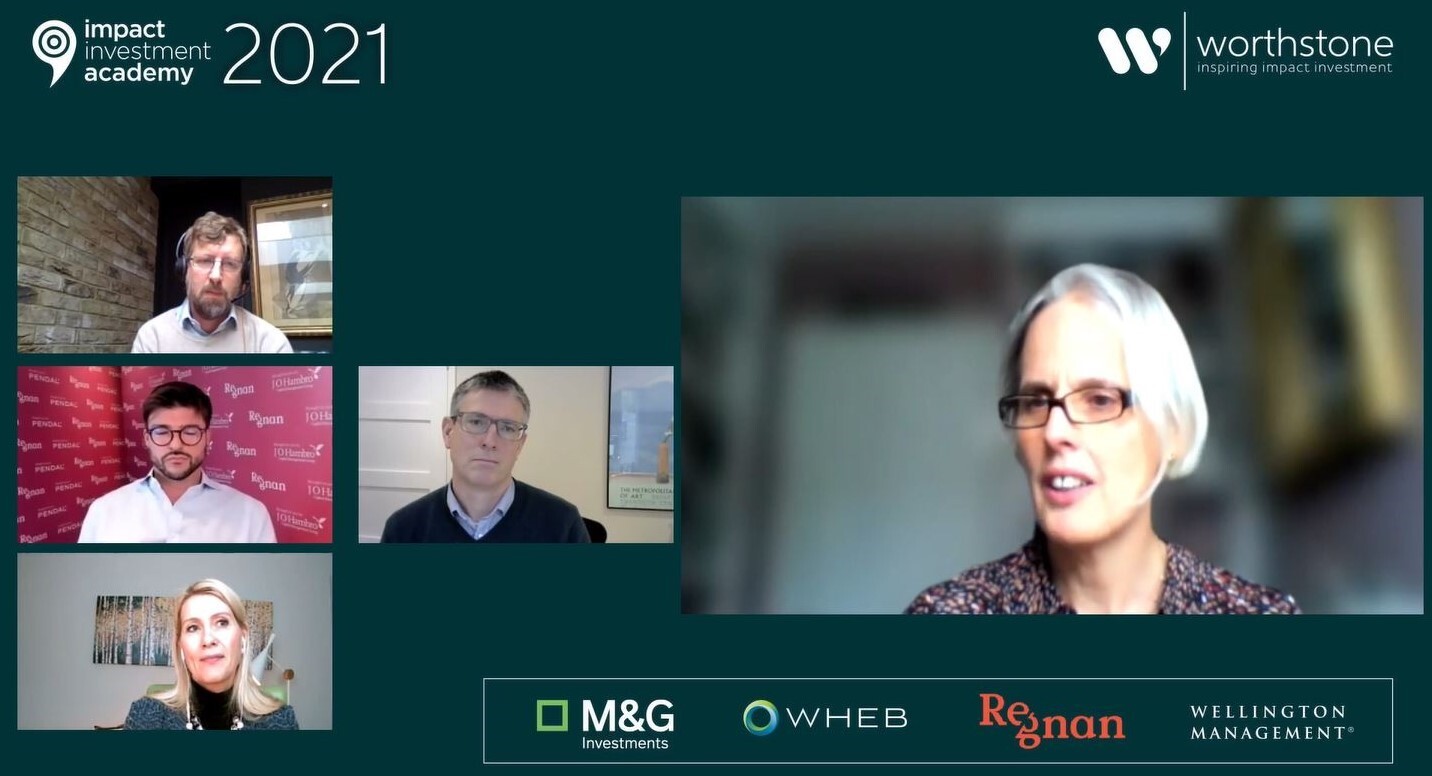ESG v Impact: what's in a name?
Dec 06 2021 · 10 minute read
The sustainable universe is rich, broad and deep. It is also open to multiple interpretations and misinterpretations. Data can be hard to read, greenwashing is widespread and terminology is often used interchangeably – ESG, ‘responsible’, ‘sustainable’, ‘thematic’ and ‘impact’ strategies are bundled together, with an assumption that they all have similar goals. Such confusion is understandable. But it is also deeply misleading. And that can have far-reaching implications.
A round table at the Impact Investment Academy aimed to address some of these challenges by lifting the lid on impact investing. Moderated by Abigail Rotheroe, our Investment Director, the round table posed a series of searching questions to a panel of four specialists in the field.
While the discussion was wide-ranging, it aimed to answer three key questions:
- What makes impact investing distinctive?
- How does it work?
- Why does it matter?
What makes impact investing distinctive?
At its simplest, impact investment strategies focus on companies that have, at their core, a determination to generate social or environmental impact through the products and services they provide. By financing these companies, investment managers are helping them to solve the specific challenges that they are working to address. Investment managers have a further role too, ensuring that companies are genuinely delivering against their promises, in a world where impact-washing is pervasive.
While most investors focus on what companies are doing, there is a second type of impact, which centres on the way that fund managers – and by extension investors - drive change and allocate capital in the impact space. First, they can provide companies with the cash they need to deliver maximum impact. Second, they can encourage businesses to adopt more progressive practices on and improve their performance on a range of environmental and social issues. Third, they can engage with financial regulators and encourage them to set higher standards across the investment universe.
Why do impact investors talk about intentionality?
As the panel made clear, intentionality lies at the heart of impact investing. A key differentiator between impact and other forms of sustainable or ESG investing, intentionality is all about the desire to generate positive environmental or social change. As such, impact investors direct capital to mission-driven businesses, whose remit is to solve a specific or a set of social or environmental challenges. The panel acknowledged that definitions can be loose but pointed out that the most strategic investors focus on companies that enable, foster and facilitate positive environmental or social impact through the solutions that they exist to sell.
Why is measurability important?
Impact measurement and management is a hallmark of impact investment - a way for businesses to prove that they are having an impact and improve that impact over time.
For members of the panel, measuring impact does not just hold companies to account, it is also a way of gauging investor performance. Given that impact investing is still at an early stage and definitions can differ, a degree of flexibility is needed – but, as the panel highlighted, fund managers also need to show that they have a system and a structure in place.
Net impact was singled out too, counterbalancing the very real positive impact that a business is striving to deliver with the challenges they may face along the way. As the panel explained, adopting a net impact approach provides a richer picture of the company, allows more effective engagement and ultimately helps to drive positive change.
How can impact investing drive change in the public markets?
Stock markets are often criticised for short-termism and a focus on financial returns rather than societal or environmental impact. But this belies the effect that thoughtful impact investing can have in these markets.
First, investors can direct capital towards impact companies that are floating on the stock market. These businesses invariably join the stock market to raise cash so they can generate more impact than they otherwise would. As such, investors who allocate capital to these flotations, known as IPOs (initial public offerings), are helping to create additional environmental or social impact. Participating in IPOs is important for a second reason too. It helps companies to maintain their impact mission, despite the challenges imposed by a stock market listing.
Investors can also drive change on the stock market after a company has floated – by buying shares in that business from other investors. Supporting the share price in this way can have numerous benefits – helping companies to invest in their business, helping them to make complementary acquisitions and incentivising employees so they feel motivated and appreciated at work.
Equally, investors can generate impact among publicly listed companies by using their position as shareholders to foster change that will further those companies’ environmental or social contribution.
Can investors achieve sufficient diversification through impact investing alone?
Here the panel were unanimous: yes, they can. Impact investment is still relatively young but it has evolved substantially in the last decade and today, the opportunity set is rich, diverse, global and growing. Neither is it limited to a single asset class. On the contrary, investors can allocate funds to a range of asset classes in both the public and private markets.
How can fund managers have an influence over the companies they invest in, even with a relatively small shareholding?
Size of stake does not always equate to depth of influence. What does make a difference is the way in which an investor is trying to drive change. Being vocal can help. And companies are more likely to follow investors’ advice if their suggestions make sense to the business and can create change.
Some companies are genuinely grateful for constructive feedback too and this can engender a positive partnership between the company, which wants to know how it can improve, and the investor, who can talk about progress that others in the market are making.
Collaborative engagement was also discussed on the panel, where investment managers join forces to drive positive change either within a single company or across the entire impact space.
Impact investing – summed up
At the end of the round table, panellists were asked what the audience should take away from the discussion. This is what they said:
- “Impact investors are looking for focused, mission-driven business that are solving some of the biggest environmental and social issues that we face. Ultimately, we are buying into a selection of companies that are the future. The investment case is the impact case.”
- “The principles behind impact investing may sound conceptual but they are really important to ensure that we don’t just claim to have a positive impact; we are actually delivering positive outcomes on the world’s biggest challenges.”
- “Impact investing is at an early stage but I think we can drive change throughout our industry. As impact investors, we set great store by transparency. Over time, I hope our movement can create a ripple effect across the entire financial services sector.”
- “This is about investing in the world we want to live in.”

The round table heard the views of four panellists:
- Seb Beloe, Partner and Head of Research at WHEB Asset Management
- Ben Constable-Maxwell, Head of Sustainable and Impact Investing, M&G Investments
- Tim Crockford, Senior Fund Manager at Regnan
- Louise Kooy-Henckel, Managing Director and Head of EMEA Sustainable Investing, Wellington Management.
The panel was chaired by Abigail Rotheroe, Investment Director at Snowball. Abigail co-authored two reports on enterprise and manager impact, which you can read by clicking here.
This conversation was part of the Worthstone Annual Impact Investing Academy. Since 2011 Worthstone, a certified B Corporation, has been helping financial advisers look beneath the label of a fund, see the full picture and make informed decisions. The Impact Portal is an online tool allowing financial advisers to quickly and easily rate the impact of a fund based on five key measures. The data is codified and visual making it digestible and engaging for clients so advisers can share the holistic performance of a fund and portfolio. For more information, contact Ben Fisher on benjamin.fisher@worthstone.co.uk
If you have any thoughts on the article or would like to learn more about Snowball, please do be in touch on hello@snowball.im
